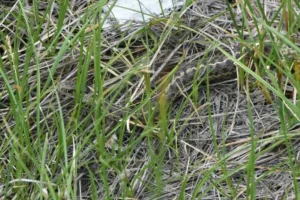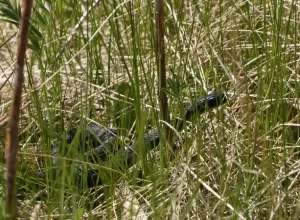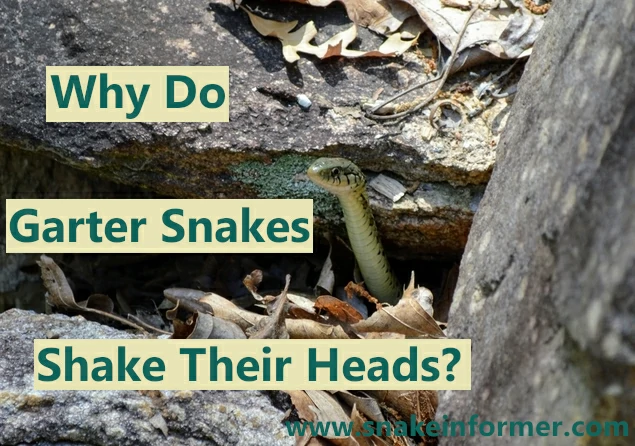Garter snakes are some of the most abundant snakes in North America. These snakes primarily inhabit grassy and forested areas, but often wander into people’s gardens and backyards.
Garter snakes bob and shake their heads primarily to mimic the movement of grass or other vegetation in windy conditions. This behavior helps them blend more effectively into their environments and avoid detection by potential predators.
Garter snakes are preyed on by many animals. Staying unnoticed is their best bet for survival.
The head-wobble can make garter snakes hiding in vegetation much more difficult for predators to spot.
Garter Snakes Shake Their Heads as a Behavioral Camouflage
Garter snakes are both predators and prey in the environments they live in.
These snakes eat, snails, insects, frogs, toads, salamanders, fish, lizards, and even small mice.
They rely on their vision and sense of smell to detect prey, then capture it by stalking ambushing, or actively chasing it.
On the other hand, Garter snakes are also hunted, and eaten by many other animals.
They are preyed on by hawks, owls, crows, eagles, raccoons, foxes weasels, large predatory fish, and even larger snakes such as Kingsnakes.
As both predator and prey, garter snakes developed several adaptations to help them hunt for prey, and also avoid predators. One of these adaptations is camouflage.
Garter employ 2 main forms of camouflage:
- Color pattern camouflage (also known as ‘background matching’)
- Behavioral camouflage
1. Color Pattern Camouflage
Garter snakes have a coloration that helps blend into their environments (this is known as ‘background matching’).
When a garter snake sees a predator, it may remain motionless, relying on its coloration to blend into the environment and go unnoticed.

Apart from avoiding predators, background-matching camouflage also helps garter snakes as they hunt for prey.
A garter snake may hide in shady areas, blending into its environment – then ambush and pounce on any prey that gets close.
In order for background matching camouflage to be successful, the snake must be almost perfectly still, or the illusion is broken.
2. Behavioral Camouflage
Background matching is not always enough for garter snakes to avoid detection.
Once the environment starts to move, a hiding garter snake that is not moving along with the environment becomes easily visible.
This is where the ‘head-wobble’ (shaking or bobbing the head) comes in.
In windy conditions, garter snakes often move their head, and the first few centimeters of the neck from side to side, while the rest of the body remains still.
The head-wobble works together with background matching, to precisely match the pattern of movement of grass in windy conditions.
This allows a garter snake to stay hidden even in dynamic conditions.
In other words, moving the head from side to side increases the efficiency of color pattern camouflage during periods of wind activity.
Garter Snakes Only Shake Their Heads in Grassy Habitats
Garter snakes will only move their heads from side to side when they are in areas with lots of wind-blown vegetation.
In one study researchers observed 73 eastern garter snakes (Thamnophis sirtalis sirtalis).
They noticed that head-wobbles were only performed by the snakes as they moved through grassy habitats with wind activity, or along pond edges among reeds.

No head-wobbles were seen in garter snakes in open water, low-cut grass, or forest conditions.
Based on this study, the researchers concluded that garter snakes selectively use the head-wobble, – depending on the wind conditions, and the type of area they are in.
Garter Snakes Usually Only Shake Their Heads When They See a Predator
Garter snakes do not always shake their heads when they are in grassy habits.
They typically only start doing so, when they are attempting to hide from a predator.
In the same study mentioned above, researchers noticed that hidden garter snakes would only begin performing a head wobble during an approach from a potential predator.
During the study, garter snakes were found hiding among vegetation.
An observer then approached one of the snakes.
The head-wobbling behavior typically only began when the observer was within 10 feet ( about 3 meters) of the snake.
It was also noticed that the snakes would often stop head-wobbling, and actively escape by hiding in the vegetation when the observer was within 3 feet (about 1 meter) of their location.
Head-Wobbling Is Not an Effective Camouflage for Large Garter Snakes
Above a particular size, head-wobbling does not help camouflage a garter snake in the grass.
Instead, the head movement makes it stand out from the environment -becoming more visible to a predator.
For this reason, other defensive strategies (such as quickly escaping when approached by a predator) are more effective than head-wobbling for larger garter snakes.
Garter Snakes Are Not the Only Snakes That Shake Their Heads
Garter snakes are not the only snakes that wobble their heads. This behavior has been observed in many other snake species.
Brown vine snakes (Oxybelis aeneus), are known to shake their heads from side to side, to better camouflage their movement as they hunt for prey.
One prey animal that these snakes hunt, the grass anole (Anolis auratus), is known to rely on motion detection to avoid predators.
An approaching snake that is mimicking the moving vegetation will be much more difficult for the lizard to spot.
Smooth Green Snakes (Opheodrys ventralis) are also known to use head-wobbling behavior to escape the notice of predators.
Scientific Information About Head-Wobbling Behavior in Snakes Is Very Limited
Head-wobbling in snakes is a very poorly studied behavior. For this reason, verifiable scientific information on this subject is extremely limited.
There are claims that head-wobbling may;
- Enhance garter snakes ability to detect scents,
- Help them socially communicate
- And help them see potential dangers and prey better
However, there is no actual scientific evidence to back these claims, so they should be taken with a grain of salt.
Conclusion
The main reason garter snakes shake their heads from side to side – is to mimic the movement of grass in windy conditions.
This behavior makes them less noticeable to approaching predators.
Garter snakes are not the only snakes that shake their heads to avoid the notice of predators.
This behavior has also been observed in other snake species, such as the brown vine snake, and the smooth green snake.
Sources:
Ryerson, W. G. (2017). A Novel Form of Behavioral Camouflage in Colubrid Snakes. Copeia, 105(2), 363–367. https://www.jstor.org/stable/26872439
Claudio Reyes-Olivares, Alex Vera-Quispe, Et al. Description of the antipredatory head-wobble behaviour in Chilean rear-fanged snakes Tachymenis peruviana Wiegmann, 1835 and Tachymenis chilensis coronellina Werner, 1898 (Serpentes, Dipsadidae). Herpetozoa 35: 155–158 (2022). DOI 10.3897/herpetozoa.35.e84842
Hi, my name is Ezra Mushala, i have been interested animals all my life. I am the main author and editor here at snakeinformer.com.

